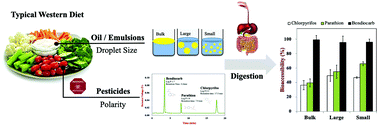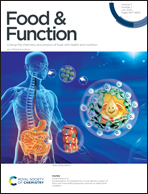Impact of pesticide polarity and lipid phase dimensions on the bioaccessibility of pesticides in agricultural produce consumed with model fatty foods
Abstract
For most people, the pesticide residues found on agriculture products are the main source of pesticide exposure, which may adversely influence consumer health. The potential health hazard of residual pesticides depends on the nature of the foods they are consumed with. Studies with fat-soluble vitamins and nutraceuticals have shown that their bioaccessibility depends on food matrix composition and structure. We used an in vitro method to investigate the influence of the dimensions of the lipid phase in model fatty foods (emulsified or bulk oil) on the bioaccessibility of various pesticides. Three pesticides that differed in their oil–water partition coefficients were selected: bendiocarb (log P = 1.7), parathion (log P = 3.8), and chlorpyrifos (log P = 5.3). These pesticides were mixed with tomato puree to represent pesticide-treated agricultural products. Three model foods with different oil phase dimensions were used to represent different kinds of food product: small emulsions (d32 = 0.14 μm); large emulsions (d32 = 10 μm); and, bulk oil. Our results showed that the oil droplets underwent extensive changes as they passed through the simulated gastrointestinal tract due to changes in environmental conditions, such as pH, ionic strength, bile salts, and enzyme activities. The initial rate and final amount of lipid hydrolysis decreased with increasing lipid phase dimensions. Pesticide bioaccessibility depended on both the hydrophobicity of the pesticide and the dimensions of the co-ingested lipid droplets. The least hydrophobic pesticide (bendiocarb) had a high bioaccessibility (>95%) that did not depend on lipid phase dimensions. The more hydrophobic pesticides (parathion and chlorpyrifos) has a lower bioaccessibility that increased with decreasing lipid phase dimensions. Our results demonstrate the critical role that food structure plays on the potential uptake of pesticides from agricultural products, like fruits and vegetables.



 Please wait while we load your content...
Please wait while we load your content...